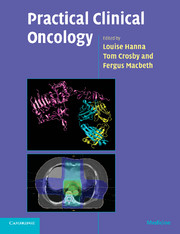Book contents
- Frontmatter
- Contents
- List of contributors
- Preface
- Acknowledgements
- Abbreviations
- 1 Practical issues in cytotoxic chemotherapy usage
- 2 Biological treatments in cancer
- 3 Hormones in cancer
- 4 Radiotherapy planning
- 5 Research in cancer
- 6 Oncological emergencies
- 7 Palliative care
- 8 Head and neck
- 9 Oesophagus
- 10 Stomach
- 11 Liver, gallbladder and biliary tract
- 12 Exocrine pancreas
- 13 Colon and rectum
- 14 Anus
- 15 Gastrointestinal stromal tumours
- 16 Breast
- 17 Kidney
- 18 Bladder
- 19 Prostate
- 20 Testis
- 21 Penis
- 22 Ovary
- 23 Body of the uterus
- 24 Cervix
- 25 Vagina
- 26 Vulva
- 27 Gestational trophoblast tumours
- 28 Lung
- 29 Mesothelioma
- 30 Soft tissue and bone tumours in adults
- 31 The lymphomas and myeloma
- 32 Central nervous system
- 33 Skin cancer other than melanoma
- 34 Melanoma
- 35 Thyroid
- 36 Neuroendocrine tumours
- 37 Cancer in children
- 38 Cancer of unknown primary
- 39 The use of radiotherapy in the treatment of benign conditions
- Multiple choice questions
- Multiple choice answers
- Index
- References
3 - Hormones in cancer
Published online by Cambridge University Press: 23 December 2009
- Frontmatter
- Contents
- List of contributors
- Preface
- Acknowledgements
- Abbreviations
- 1 Practical issues in cytotoxic chemotherapy usage
- 2 Biological treatments in cancer
- 3 Hormones in cancer
- 4 Radiotherapy planning
- 5 Research in cancer
- 6 Oncological emergencies
- 7 Palliative care
- 8 Head and neck
- 9 Oesophagus
- 10 Stomach
- 11 Liver, gallbladder and biliary tract
- 12 Exocrine pancreas
- 13 Colon and rectum
- 14 Anus
- 15 Gastrointestinal stromal tumours
- 16 Breast
- 17 Kidney
- 18 Bladder
- 19 Prostate
- 20 Testis
- 21 Penis
- 22 Ovary
- 23 Body of the uterus
- 24 Cervix
- 25 Vagina
- 26 Vulva
- 27 Gestational trophoblast tumours
- 28 Lung
- 29 Mesothelioma
- 30 Soft tissue and bone tumours in adults
- 31 The lymphomas and myeloma
- 32 Central nervous system
- 33 Skin cancer other than melanoma
- 34 Melanoma
- 35 Thyroid
- 36 Neuroendocrine tumours
- 37 Cancer in children
- 38 Cancer of unknown primary
- 39 The use of radiotherapy in the treatment of benign conditions
- Multiple choice questions
- Multiple choice answers
- Index
- References
Summary
Introduction
Hormonal therapies are some of the oldest active systemic anticancer therapies in use today. In 1896 Beatson demonstrated that surgical oophorectomy resulted in tumour regression in some premenopausal women with metastatic breast cancer, and, by doing so, he was the first to identify a link between ovarian function and breast cancer.
Substantial evidence now exists that hormones play a key role in both the cause and the outcome of several cancers. Although this is most clearly seen in breast and prostate cancer, other cancers that may exhibit hormone dependence include endometrial, ovarian and testicular cancers.
Hormones are classified into two groups:
Non-steroidal hormones include peptides, polypeptides or derivatives of amino acids, and they generally act via cell-membrane-localised receptors which trigger second messengers within the cytoplasm.
Steroidal hormones, such as oestrogens, androgens and progestins, bind to intracellular receptors to mediate their action.
This chapter will focus primarily on the steroidal hormones that are of particular importance in breast and prostate cancer: the oestrogens, progestins and androgens. It should be read in conjunction with the relevant site-specific chapters (Chapters 16 and 19). This chapter provides some background knowledge of the production and functioning of hormones and their receptors, which will help in the understanding of commonly used therapies. The aetiology of hormone-related cancers is discussed in the relevant site-specific chapters.
Steroidal hormones have the potential to activate oncogenes or inactivate tumour-suppressor genes, which can produce a sequence of changes within the cell that ultimately leads to cancer.
- Type
- Chapter
- Information
- Practical Clinical Oncology , pp. 23 - 38Publisher: Cambridge University PressPrint publication year: 2008

